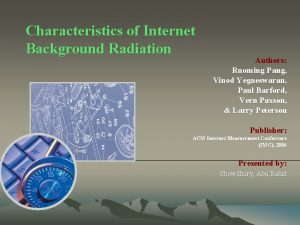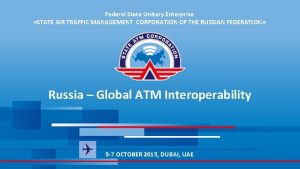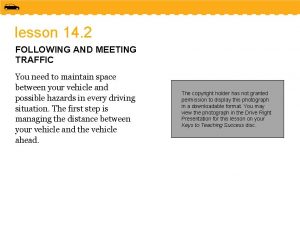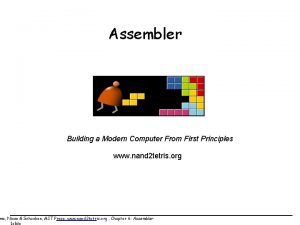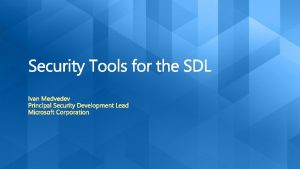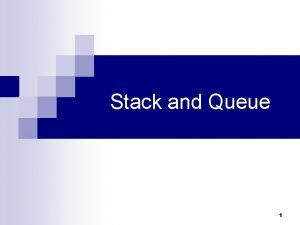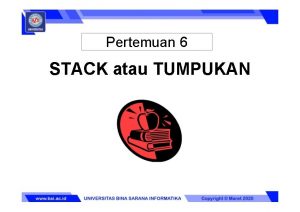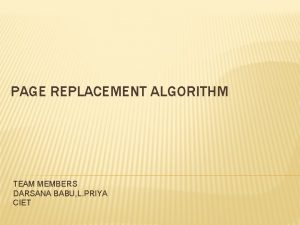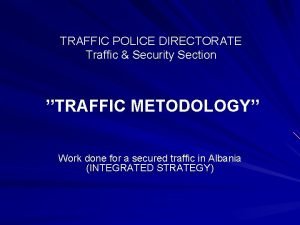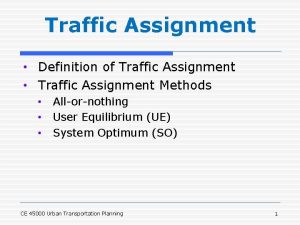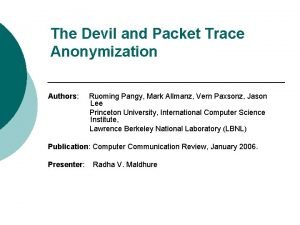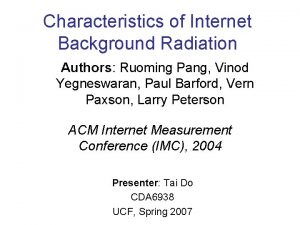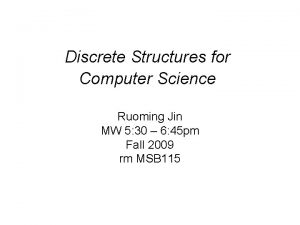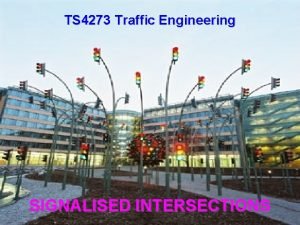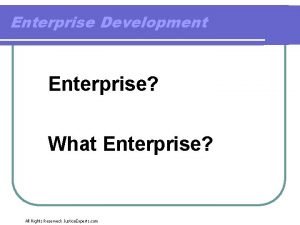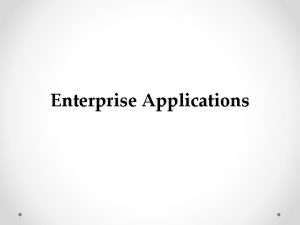A First Look at Modern Enterprise Traffic Ruoming









































- Slides: 41

A First Look at Modern Enterprise Traffic Ruoming Pang, Princeton University Mark Allman (ICSI), Mike Bennett (LBNL), Jason Lee (LBNL), Vern Paxson (ICSI/LBNL), and Brian Tierney (LBNL)

The Question “What does the traffic look like in today’s enterprise networks? ” • Previous work – LAN traffic [Gusella 1990, Fowler et. al. 1991] – More recent work on individual aspects: • Role classification [Tan et. al. 2003], • Community of interest [Aiello et. al. 2005] • Wide area Internet traffic measurements – First study: [Cáceres 1989] … when the size of Internet was ~130, 000 hosts … about the size of a large enterprise network today

Our First Look • Which applications account for most traffic? • Who is talking to whom? • What’s going on inside application traffic? – Esp. ones that are heavily used but not well studied: Netware Core Protocol (NCP), Windows CIFS and RPC, etc. • How often is the network overloaded? For all above, compare internal vs. wide area

Trace Collection • Where: Lawrence Berkeley National Lab (LBNL) – A research institute with a medium-sized enterprise network • Caveat: one-enterprise study – “The traffic might look like …” • How: tapping links from subnets to the main routers • Caveat: only traffic between subnets

LBNL Trace Data D 0 Date Duration D 1 D 2 D 3 Oct 4, 04 Dec 15, 04 Dec 16, 04 D 4 Jan 6, 05 Jan 7, 05 10 min 1 hour 22 22 22 18 18 Traced Hosts 2, 531 2, 102 2, 088 1, 561 1, 558 Packets 18 M 65 M 28 M 22 M 28 M Snaplen 1500 68 68 1500 Subnets • Five data sets • Over three months: Oct 2004 -- Jan 2005

LBNL Trace Data D 0 Date Duration D 1 D 2 D 3 Oct 4, 04 Dec 15, 04 Dec 16, 04 D 4 Jan 6, 05 Jan 7, 05 10 min 1 hour 22 22 22 18 18 Traced Hosts 2, 531 2, 102 2, 088 1, 561 1, 558 Packets 18 M 65 M 28 M 22 M 28 M Snaplen 1500 68 68 1500 Subnets • Each trace covers a subnet • Lasts ten minutes or one hour

LBNL Trace Data D 0 Date Duration D 1 D 2 D 3 Oct 4, 04 Dec 15, 04 Dec 16, 04 D 4 Jan 6, 05 Jan 7, 05 10 min 1 hour 22 22 22 18 18 Traced Hosts 2, 531 2, 102 2, 088 1, 561 1, 558 Packets 18 M 65 M 28 M 22 M 28 M Snaplen 1500 68 68 1500 Subnets • Two sets of subnets • 2, 000 hosts traced per data set

LBNL Trace Data D 0 Date Duration D 1 D 2 D 3 Oct 4, 04 Dec 15, 04 Dec 16, 04 D 4 Jan 6, 05 Jan 7, 05 10 min 1 hour 22 22 22 18 18 Traced Hosts 2, 531 2, 102 2, 088 1, 561 1, 558 Packets 18 M 65 M 28 M 22 M 28 M Snaplen 1500 68 68 1500 Subnets • Subnets are traced two at a time – With four NIC’s on the tracing machine

LBNL Trace Data D 0 Date Duration D 1 D 2 D 3 Oct 4, 04 Dec 15, 04 Dec 16, 04 D 4 Jan 6, 05 Jan 7, 05 10 min 1 hour 22 22 22 18 18 Traced Hosts 2, 531 2, 102 2, 088 1, 561 1, 558 Packets 18 M 65 M 28 M 22 M 28 M Snaplen 1500 68 68 1500 Subnets • Packets with full payloads allow application-level analysis

Outline of This Talk • Traffic breakdown – Which applications are dominant? • Origins and locality • Individual application characteristics

Network Layer: Is IP dominant? • Yes, most packets (96 -99%) are over IP – Caveat: inter-subnet traffic only • Aside from IP: ARP, IPX (broadcast), etc.

Transport Layer • Protocols seen: – TCP, UDP, ICMP – Multicast: IGMP, PIM – Encapsulation: IP-SEC/ESP, GRE – IP protocol 224 (? ) • Is UDP used more frequently inside enterprise than over wide area Internet?

TCP vs. UDP / WAN vs. Enterprise Breakdown by Payload Bytes

Breakdown of the first data set (D 0) (Bars add up to 100%)

80% (or more) payloads are sent within the enterprise.

Yes, UDP is used more frequently inside the enterprise.

Breakdown by Flows

Application Breakdown by Bytes

net-file: NFS, Netware Core Protocol Application Breakdown by Bytes

bulk: FTP, HPSS Application Breakdown by Bytes

windows: Port 135, 139, and 445 Application Breakdown by Bytes

Bars for each data set add up to 100%

net-file: NFS NCP backup: Dantz Veritas Internal Heavy-Weights

WAN ≈ web + email WAN Heavy-Weights

name: DNS WINS Breakdown by Flows misc: Calendar Card. Key

Summary of Traffic Breakdown • Internal traffic (vs. wide area) – Higher volume (80% of overall traffic) – A richer set of applications • Traffic heavy-weights – Internal: network file systems and backup – WAN: web and email

Outline • Traffic breakdown • Origins and locality – Fan-in/out distribution • Individual application characteristics


Half of hosts have no wide-area fan-out (in one hour).

Internal fan-out has a fat tail.

Most hosts have fan-in of no more than 10.

Outline • Traffic breakdown • Origins and locality – Fan-in/out distribution • Individual application characteristics

Example Questions • Is there a big difference between internal and wide area HTTP traffic? • How different are DNS and WINS (netbios/ns)? • What does Windows traffic do?

Internal HTTP traffic Automated clients vs. the rest: Requests Bytes D 0 D 3 D 4 Internal Scanners 20% 49% 19% 0. 1% 0. 9% 1% Google Devices 37% 8% 5% 96% 69% 48% Netware i. Folder 1% 0. 2% 10% 0. 0% 9% All other clients 42% 43% 66% 4% 30% 41% Automated clients dominate the traffic.

DNS vs. WINS • Where do queries come from? – DNS: both local and remote; most queries come from two mail servers – WINS: local clients only; queries are more evenly distributed among clients • Failure rate (excluding repeated queries) – DNS: 11 -21% – WINS: 36 -50% (!)

Windows Traffic Port 139 Port 445 NETBIOS File Sharing CIFS/SMB Port 135 Dynamic Ports Port numbers don’t tell much… LAN Browsing DCE/RPC Endpoint Mapper DCE/RPC Services (logon, msgr, etc. )

Windows Traffic Port 139 Port 445 Port 135 Dynamic Ports NETBIOS File Sharing CIFS/SMB LAN Browsing DCE/RPC Endpoint Mapper DCE/RPC Services (logon, msgr, etc. ) Application level analysis: Bro + binpac

Windows Traffic Breakdown • Majority of CIFS/SMB traffic is for DCE/RPC services – Rather than file sharing • Majority of RPC traffic – By request: user authentication (netlogon), security policy (lsarpc) and printing (spoolss) – By size: printing (spoolss)

Not Covered in This Talk … • Characteristics of more applications – Email – Network file systems: NFS and NCP – Backup – Further details about HTTP, DNS/WINS, and Windows traffic • Network congestion

Conclusion • A lot is happening inside enterprise – More packets sent internally than cross border – A number of applications seen only within the enterprise • Caveats – – One enterprise only Inter-subnet traffic Hour-long traces Subnets not traced all at once • Header traces released for download! – To come: traces with payloads (HTTP, DNS, …)

The End To download traces: http: //www. icir. org/enterprise-tracing (or search for “LBNL tracing”)
 Looking down to the left
Looking down to the left Internet background radiation
Internet background radiation Ruoming jin
Ruoming jin Incomina
Incomina Intelligent traffic solutions
Intelligent traffic solutions Enterprise traffic management
Enterprise traffic management Chapter 9 driving in urban traffic
Chapter 9 driving in urban traffic Romeo juliet translation
Romeo juliet translation Putting the enterprise into the enterprise system
Putting the enterprise into the enterprise system Putting the enterprise into the enterprise system
Putting the enterprise into the enterprise system Meeting traffic
Meeting traffic Activity 1.picture identification
Activity 1.picture identification Activity 1 look at the picture
Activity 1 look at the picture Look at activity 1 and answer
Look at activity 1 and answer Ibm's first 64 bit enterprise operating system
Ibm's first 64 bit enterprise operating system Leaner messages are always less effective
Leaner messages are always less effective Build a modern computer from first principles
Build a modern computer from first principles Why was the civil war the first modern war
Why was the civil war the first modern war Origin of the olympics
Origin of the olympics Sharpen the saw examples
Sharpen the saw examples Recursive breadth first search
Recursive breadth first search Sdl first vs code first
Sdl first vs code first Put first things first activities
Put first things first activities Put first things first
Put first things first Difference between code first and database first approach
Difference between code first and database first approach First to invent or first to file
First to invent or first to file Data structure stack
Data structure stack Perintah isempty create stack hasilnya adalah
Perintah isempty create stack hasilnya adalah First in first out
First in first out First come first serve
First come first serve Put first things first definition
Put first things first definition First come first serve calculator
First come first serve calculator Synergy action plan
Synergy action plan Habit 3 activities
Habit 3 activities Put first things first video
Put first things first video Habit 3 activities
Habit 3 activities First aid merit badge first aid kit
First aid merit badge first aid kit Objective of first aid
Objective of first aid 7 habits promise
7 habits promise Traffic control austin
Traffic control austin Volusia county traffic engineering
Volusia county traffic engineering Utility work zone traffic control
Utility work zone traffic control

